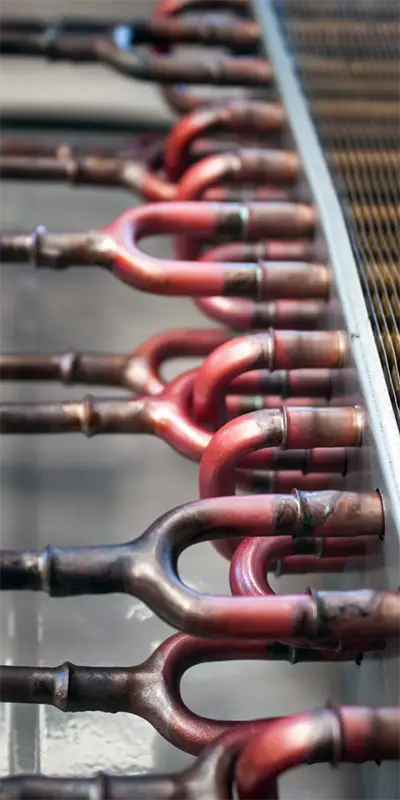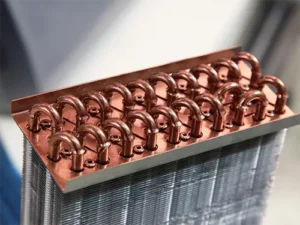 The heat exchanger is the main part of your furnace. It transfers heat from burning fuel into the air that warms your home.
The heat exchanger is the main part of your furnace. It transfers heat from burning fuel into the air that warms your home.
Its role is very important. It keeps harmful gases, like carbon monoxide, away from the air you breathe. If it fails, your heating system’s safety and efficiency are compromised, posing serious health risks.
A cracked heat exchanger is no small issue. Toxic gases could leak into your home, putting your family at risk. Recognizing the warning signs and taking action is essential.
This guide will help you understand how heat exchangers work, why they fail, the dangers of cracks, and what to do if you suspect an issue.
Key Takeaways
- Heat exchangers are essential for safe and efficient furnace operation.
- Cracks in a heat exchanger can lead to toxic gas leaks, including carbon monoxide.
- Signs of a cracked heat exchanger include unusual smells, noises, soot buildup, and changes in flame appearance.
- Routine maintenance and annual inspections help prevent heat exchanger damage.
- If you suspect a problem, consult a professional immediately.
How Does a Furnace Heat Exchanger Work?
A gas furnace heat exchanger consists of metal coils or tubes surrounded by air. When your furnace operates, gas or electric connections heat these coils. As air moves over the coils, it absorbs heat and circulates through your home via ducts and vents.
The heat exchanger also ensures safety by maintaining an airtight seal. This seal prevents dangerous flue gases like carbon monoxide from mixing with the breathable air. If the heat exchanger cracks, this barrier is compromised, allowing harmful gases to enter your home’s air supply.
Why Heat Exchangers Fail
 Heat exchanger failure is often preventable with proper care, but various factors can contribute to cracks.
Heat exchanger failure is often preventable with proper care, but various factors can contribute to cracks.
Clogged Air Filters
A clogged air filter restricts airflow, causing the furnace to overheat. Prolonged overheating puts stress on the metal, leading to cracks. Replacing air filters regularly is an easy way to reduce this risk.
Improper Furnace Sizing
An oversized furnace heats the home too quickly, cycling on and off frequently. This rapid cycling accelerates wear and tear on the heat exchanger, increasing the likelihood of cracks.
Furnace Age
Heat exchangers have a typical lifespan of 15–20 years. Over time, the constant heating and cooling cycles weaken the metal, making cracks more likely as the furnace ages.
Skipping on Heater Maintenance
Annual HVAC inspections and routine maintenance are critical. Regularly changing air filters, cleaning components, and addressing minor issues can prevent strain on the heat exchanger and keep it in good condition.
The Dangers of a Cracked Heat Exchanger
A cracked heat exchanger can allow toxic gases to seep into your home, including:
- Carbon Monoxide (CO): An odorless, colorless gas that can cause flu-like symptoms, confusion, or even death in high concentrations.
- Sulfur Dioxide (SO₂): Can irritate the respiratory system, causing coughing and shortness of breath.
- Nitrous Oxide (NOx): Prolonged exposure can lead to respiratory issues and reduced lung function.
Homeowner awareness and proactive maintenance are key to preventing these risks.
Signs Your Furnace Heat Exchanger May Be Cracked
Identifying a cracked heat exchanger early can prevent more serious issues. Watch for these signs:
Strange Smells
A chemical or formaldehyde-like smell may indicate a cracked heat exchanger. This differs from the “dusty” odor common when starting the furnace for the first time in the season.
Strange Sounds
Rattling, popping, or banging noises during operation can signal metal expansion and contraction, potentially caused by cracks.
Soot Buildup
White soot around burners suggests incomplete combustion, which could result from a damaged heat exchanger.
Corrosion
Moisture can corrode the metal over time, leading to visible damage. Check components like the draft diverter box and inducer motor for signs of deterioration.
Change in Flame Appearance
A healthy furnace flame is steady and blue. A yellow or flickering flame can indicate inefficient burning and potential cracks.
Recurring Flu Symptoms
Headaches, nausea, and fatigue among household members may result from low-level carbon monoxide exposure.
Furnace Failure
A non-functioning furnace can be a blessing in disguise, as it may prevent dangerous leaks. Treat furnace failure as a potential warning sign.
Carbon Monoxide Detectors Keep Going Off
If your detectors are triggering frequently, your furnace could be the issue. Never ignore a carbon monoxide alarm.
What You Should Do If You Suspect a Cracked Heat Exchanger
Take immediate action if you suspect a cracked heat exchanger:
- Evacuate your home if carbon monoxide is present.
- Call emergency services if necessary.
- Contact a qualified HVAC technician to assess and repair the issue.
Avoid DIY repairs. Heat exchanger damage requires specialized knowledge and tools.
Repair or Replace?
The decision to repair or replace depends on several factors:
- Repair: If the damage is minimal, replacing the heat exchanger cell may be an option. However, repairs can be costly and may not always be a long-term solution.
- Replace: If repair costs exceed the value of your furnace, upgrading to a new system is the better choice. Modern furnaces are more efficient and reliable, saving you money in the long run.
One Hour Can Help With Heater Issues
 Preventive maintenance is your best defense against costly repairs and dangerous conditions. Regular HVAC system check-ups can catch problems like cracked heat exchangers early.
Preventive maintenance is your best defense against costly repairs and dangerous conditions. Regular HVAC system check-ups can catch problems like cracked heat exchangers early.
One Hour offers heater tune-ups, repairs, and installations for homeowners in Orlando, FL, and surrounding areas. Remember, we’re always on time or you don’t pay a dime!
FAQs
What causes a heat exchanger to crack?
Clogged air filters, improper furnace sizing, lack of maintenance, and age-related wear and tear are common causes.
Can a cracked heat exchanger be repaired?
In some cases, yes, but repairs can be expensive and may not guarantee long-term reliability.
Is a cracked heat exchanger dangerous?
Yes, it can allow toxic gases like carbon monoxide to leak into your home, posing serious health risks.
How often should I schedule furnace maintenance?
Annual maintenance is recommended to keep your heating system in good condition.
Final Thoughts
Recognizing the signs of a cracked heat exchanger is crucial for your family’s safety. Regular maintenance and prompt action can prevent costly repairs and dangerous conditions.
If you think there is a problem, don’t wait. Schedule a heater tune-up with One Hour today. This will help make sure your system is working safely and efficiently.